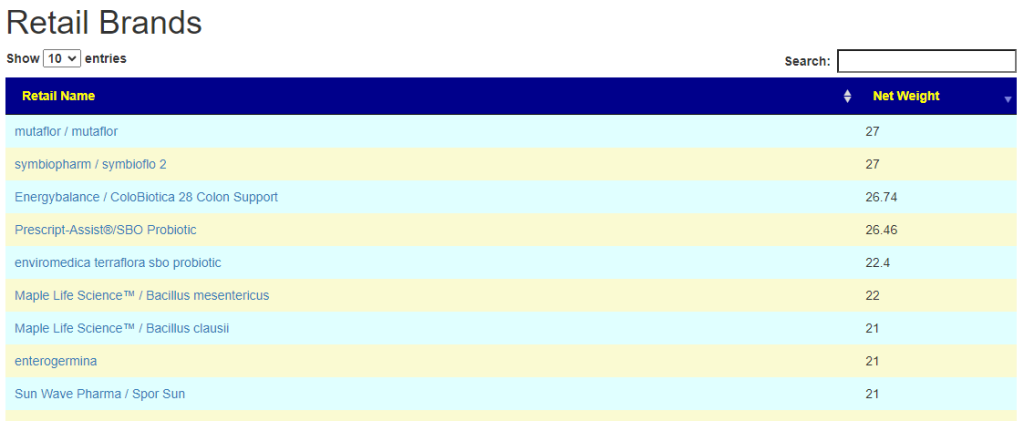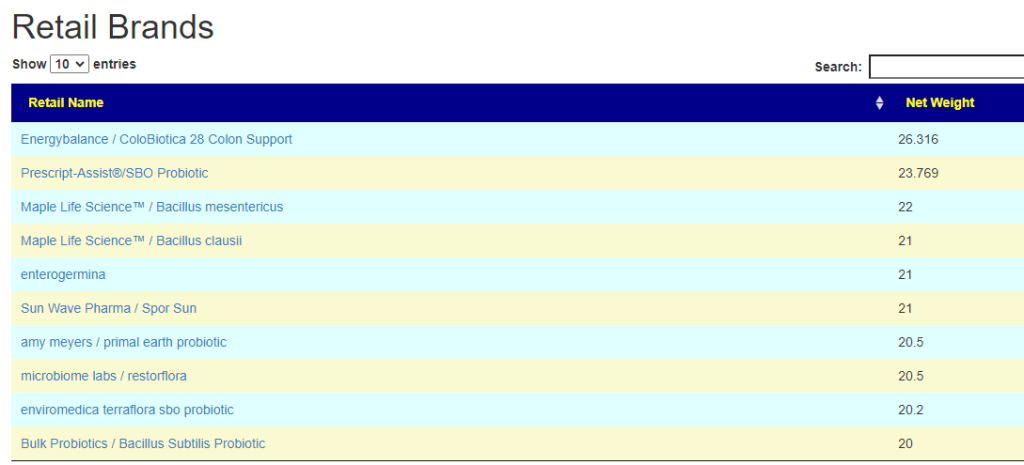Backstory
I’m writing today to get your guidance. I recently got back my 5th microbiome sample and I haven’t made significant progress. I suspect it’s because of the food I eat, and I’m hoping you can help advise me of what to eat.
Earlier post: Another ME/CFS person has gone to Firmicutes! [Jan 2023]
My hypothesis as to why i’m not getting better results is that I haven’t followed the dietary recommendations very closely.
The recommendations are to basically eat a carnivore diet. My main diet… Fruit, Oats, Rice, Potatoes, Nuts, Wheat and cheese are all hugely negative. Thus, I think this is what’s holding me back. It’s nice to identify the problem, but the solution isn’t easy.
The only thing for me to eat on the recommendation list is Meat. Even vegetables are mostly disallowed because I’m supposed to eat low fiber.
Is that your understanding as well from the recommendations – that I should be nearly 100% meat (and possibly eggs), with some low fiber vegetables? It’s hard for me because i prefer to be vegan. But i’ll do whatever I need to fix my gut.
Note: 4 months ago I completely eliminated wheat and cheese and I started eating beef once a day. That helped but it doesn’t seem to be enough, which is why I’m reaching out to inquire what to eat.
I think I can withdraw my question. I didn’t know what I would eat when meat showed up on my Suggestions list as basically the only option. But I’m having miso or bone broth soup for breakfast, eggs for lunch, and meat for dinner… and that feels sustainable for me. So far I think it’s working. Time will tell.
Over the last 18 months i’ve had some good days and even a good week here and there, which has given me hope that your approach holds the solution i’ve dedicated a lot of my life to over the last 15 years. However I always gravitate back to my baseline of feeling crummy.
I thought that taking all the top suggested pills, and cutting out the foods with very negative Priority score would be enough, but I now believe that my diet of mostly oatmeal, nuts, beans, (and previously wheat) has been holding me back. All those items have a negative Priority scores, and my recommendation list very clearly points to red meat, low fiber, low carb.
First Step: Compare Last to First Sample
This immediately ran into issues with sample quality. One sample produced 723 bacteria versus 434, i.e. 66% more. It makes comparing the numbers very difficult.
| Criteria | Current Sample | Old Sample |
| Lab Read Quality | 11.8 | 4.3 |
| Outside Kaltoft-Møldrup | 220 | 86 |
| Bacteria Reported By Lab | 723 | 435 |
| Bacteria Over 85%ile | 84 | 66 |
| Bacteria Under 15%ile | 268 | 58 |
| Lab: Thryve | ||
| Pathogens | 33 | 20 |
| Condition Est. Over 85%ile | 2 | 10 |
| Kegg Compounds Low | 238 | 331 |
| Kegg Compounds High | 196 | 309 |
| Kegg Enzymes Low | 83 | 479 |
| Kegg Enzymes High | 322 | 237 |
A second approach is to compare forecast symptoms
| Current Sample | First Sample |
 |  |
The surprising thing is how close both sets of forecasts are to each other, often with less than 1% difference. The reader’s “I haven’t made significant progress” appears to be right on. This is the first repeat analysis that there was not objective improvement all. The expert system is not perfect.
Going Forward — let us try getting religious on suggestions!
I am going to do three approaches to try helping this person:
- Stock suggestions from the Expert System using the simplified UI. This used only studies on PubMed to try to shift the microbiome.
- Using the Food Site – This use the nutrients identified as significant and tries to map them to a wide variety of foods (infer from nutrients to food)
- Probiotics using KEGG – this uses no explicit studies, rather identify what substances that the microbiome may be starving for, then identify any probiotics that produces those substances. The reasoning is that the starvation contributes to the dysfunction.
Remember, everything are estimates of likely to help (or hurt). Estimates can be wrong. In some cases, it may be worthwhile to do a short term trial to see if there are any immediate changes. This applies especially to anything that is a mixture because the good may overpower the bad (or the reverse).
Simplify UI
We get 137 (out of 723, i.e. ) or 19%. The top diet types are shown below

We see high values for:
- diosmin polyphenols at 340
- high red meat at 423
- Crataegus {Hawthorn} Herb at 320
- Carrageenans {Carrageenan}
- With inulin, the basic form is a big -1040, while oligofructose-enriched inulin is a positive but different forms of oligofructose are all negatives — so would definitely avoid all inulin
- probiotics are low in ranking
- Biotin {Vitamin B7} is the top suggestion
I had the same takeaway about inulin! The basic form was super negative but the oligofructose enriched was very positive. Not going to risk touching it.
Similar thing with “low-fat high-complex carbohydrate” diet, which has a positive Priority score of 237. However, “Slow digestible carbohydrates” are negative 634 AND a “restricted-fiber diet” is hugely positive. It would seem to me that eating low-fat high complex carbs is way too risky 🙂
Reader Feedback
The hard part – AVOIDS
The list contain many items that are often seen as to take.

Over to Food Helper
The food site, Microbiome Prescription Food And Nutrients is designed to bridge the gap between some nutrient tested in studies and foods it is found in. The food are often not tried in studies – so this is an inference because of sparse data. It should always be used with a grain of sodium chloride (salt).
The quick take list suggests:
- American cranberry (a good seasonal food)
- Seal, Whale, Beluga, Canada Goose and then ham sausage!!!
- Bột cá (Fish Meal)
- Beet root, peeled, boiled, drained (without salt)
- Okra stew, (Thelele lobala lokupa)
- Onion, fresh, boiled (without salt), drained
- Turmeric, dried, ground
The suggested nutrients are shown below

Take translates to American cranberry, raw black olives, a variety of fish
And these are the to avoid

Avoids translates to Vinegar, Almond, Red wine, chocolate
I will leave it to the reader to dig more on the food site. It may reveal what may have gone wrong.
KEGG Probiotics
This is an alternative way to determine probiotics working off compounds and enzymes produced (or not produced) compare to an estimated norm.
The results are shown below (first compounds and then enzymes). Suggestions are similar with the exception of the E.Coli probiotics. I would suggest these two:
- Bacillus clausii (linked to source)
- Bacillus mesentericus
Note: Prices include shipping anywhere in the world. These are typically manufactured weeks before shipping (have manufactured date) and thus alive. If you double the number of capsules, the costs usually go up by 20% only (see example below) and the price is awesome!!


| $.29 per capsule | $.20 per capsule | $.15 per capsule |
 |  |  |
I just ordered the bacillus clausii and the bacillus mesentericus you recommended. Thanks for making it so easy and linking it to an eBay seller!..
[Update] I just cancelled the bacillus mesentericus and the bacillus clausil you linked to. They both contain fructooligosaccharids, which are a negative 193.
Question: Why did I skip Mutaflor?
- Items that are on both list are more likely (better odds) of having a positive impact. I am an odds-person (i.e. a statistician).
- Also, Mutaflor has a large number of additives: The other ingredients include maltodextrin, talc, methacrylic acid-methylmethacrylate copolymer, macrogol, triethyl citrate, glycerol, titanium dioxide, iron(III)-oxide, white beeswax, carnauba wax, shellac, and purified water
Probiotics Solutions when additives are a problems
There are two providers with no declared additives that I know of:
- Custom Probiotics :they list all of their strains — many are researched on the above list. No other ingredients just the bacteria.
- Bulk Probiotics: US based Newbie — but has some species not available at the other two sites. No other ingredients just the bacteria.
Postscript and Reminder
As a statistician with relevant degrees and professional memberships, I present data and statistical models for evaluation by medical professionals. I am not a licensed medical practitioner and must adhere to strict laws regarding the appearance of practicing medicine. My work focuses on academic models and scientific language, particularly statistics. I cannot provide direct medical advice or tell individuals what to take or avoid.My analyses aim to inform about items that statistically show better odds of improving the microbiome. All suggestions should be reviewed by a qualified medical professional before implementation. The information provided describes my logic and thinking and is not intended as personal medical advice. Always consult with your knowledgeable healthcare provider.
Implementation Strategies
- Rotate bacteria inhibitors (antibiotics, herbs, probiotics) every 1-2 weeks
- Some herbs/spices are compatible with probiotics (e.g., Wormwood with Bifidobacteria)
- Verify dosages against reliable sources or research studies, not commercial product labels. This Dosages page may help.
- There are 3 suppliers of probiotics that I prefer: Custom Probiotics , Maple Life Science™, Bulk Probiotics: see Probiotics post for why
Recent Comments